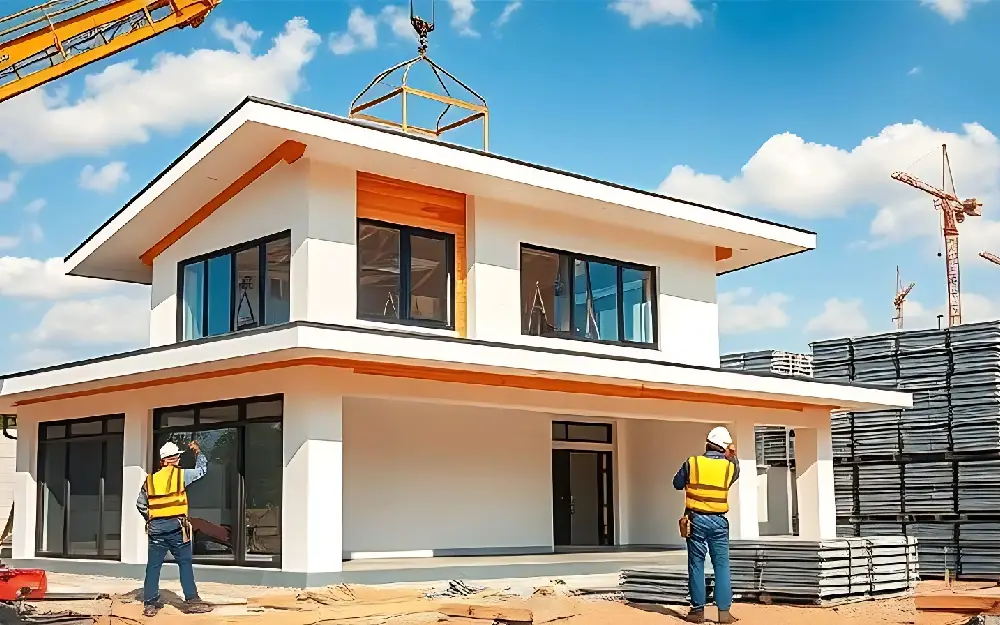
Building Homes with Prefabricated, Factory-Constructed Roof Systems: A Game Changer in Home Construction
The construction industry is constantly evolving, and one of the most exciting advancements in recent years is the use of prefabricated, factory-constructed roof systems. These innovative roof solutions are transforming how homes are built, offering increased efficiency, sustainability, and cost savings. In this blog, we’ll explore the benefits of using prefabricated roofs, how they work, and why they’re becoming a popular choice for modern home construction.
What Are Prefabricated, Factory-Constructed Roof Systems?
Prefabricated roof systems are roof structures that are built in a controlled factory environment before being transported to the construction site. These roofs are pre-assembled with all necessary components, including trusses, insulation, and sheathing, ensuring that the roof is both structurally sound and energy-efficient. Once on-site, the prefabricated roof sections are quickly lifted into place, dramatically reducing the time required for roof installation.
The Benefits of Prefabricated Roof Systems
- Faster Construction Time
One of the most significant advantages of prefabricated roof systems is the speed of installation. Traditional roof construction can take weeks, depending on weather conditions and the complexity of the design. However, with prefabricated roofs, much of the work is completed off-site in a factory, allowing the roof sections to be installed in a matter of days once they reach the site. This reduces the overall construction timeline, allowing homeowners to move in faster. - Enhanced Quality Control
When roofs are built in a factory, they are constructed in a controlled environment where conditions such as temperature and humidity are regulated. This results in higher-quality materials and craftsmanship compared to traditional on-site construction, where the elements can negatively impact the materials and workmanship. Factory-built roof systems also undergo rigorous quality control checks, ensuring that each component meets industry standards. - Cost Savings
While the initial cost of prefabricated roof systems might seem higher than traditional roofing, the long-term savings are significant. The faster construction time reduces labor costs, and the precise manufacturing process minimizes material waste. Additionally, the energy-efficient properties of these roofs can lead to reduced heating and cooling costs over the life of the home, providing long-term savings for homeowners. - Energy Efficiency
Prefabricated roofs can be designed with energy efficiency in mind. Many of these roof systems incorporate advanced insulation materials, which help to regulate indoor temperatures and reduce energy consumption. In addition, because the roofs are pre-assembled, there are fewer gaps and air leaks, which further enhances their energy performance. For homeowners looking to reduce their carbon footprint, prefabricated roofs are an ideal choice. - Sustainability
In today’s environmentally conscious world, sustainability is a key factor in home construction. Prefabricated roof systems are more sustainable than traditional roofing methods because they produce less waste during the construction process. The controlled factory environment ensures that materials are used efficiently, and excess materials are recycled or repurposed. Additionally, the energy efficiency of these roofs contributes to a home’s overall sustainability, making them a great option for eco-friendly building projects.
How Prefabricated Roof Systems Work
The process of building a home with a prefabricated roof system starts with careful planning and design. The roof components are custom-made to fit the specific dimensions of the home, ensuring a perfect fit. Once the design is finalized, the roof sections are manufactured in a factory, where all necessary components are assembled and tested.
After the roof is constructed, the sections are transported to the construction site, where cranes or other machinery are used to lift and position them onto the home’s structure. The installation process is quick, and in many cases, the roof can be fully installed within a few days.
Why Are Prefabricated Roof Systems Gaining Popularity?
The popularity of prefabricated roof systems has surged in recent years, and for good reason. Homebuilders and contractors are increasingly turning to these systems due to the numerous benefits they offer. From faster build times to improved energy efficiency, prefabricated roofs are an excellent choice for those looking to streamline their construction projects while still ensuring a high-quality, durable roof.
Additionally, as the demand for sustainable building practices grows, more and more homeowners are seeking out energy-efficient, eco-friendly solutions like prefabricated roof systems. These roofs not only reduce a home’s energy consumption but also contribute to a more sustainable construction process, making them an attractive option for environmentally-conscious buyers.
Conclusion
Prefabricated, factory-constructed roof systems are revolutionizing the home construction industry, offering a range of benefits that include faster installation, improved quality control, cost savings, and enhanced energy efficiency. As technology continues to evolve, it’s clear that these innovative roof systems will play a major role in shaping the future of homebuilding.
Whether you’re a homeowner looking to reduce your energy bills, a builder seeking to cut down on construction time, or someone simply looking for a more sustainable building solution, prefabricated roof systems are a smart choice. As more people become aware of their benefits, it’s likely that this approach to homebuilding will become even more widespread in the years to come.
